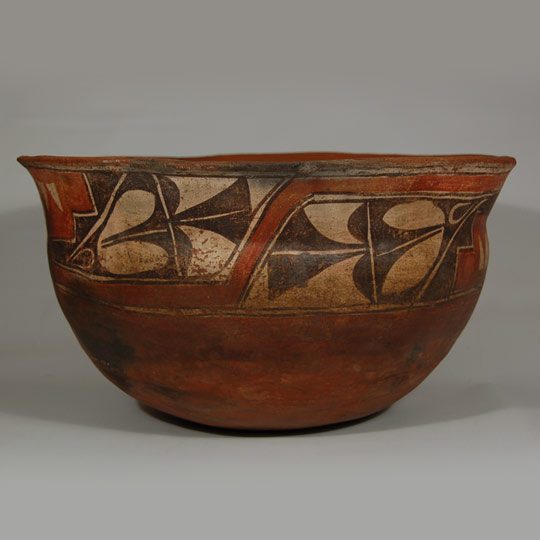Adobe Gallery Blog
Subject: Zia Pueblo 19th Century Dough Bowl
Dough bowls apparently were not made at Zia Pueblo before the late 1700s, possibly because of the difficulty in firing such large vessels or perhaps because smaller bowls served the purpose and larger ones were not needed. The experience gained in making large storage jars for storage of dried foods and other necessities eventually paved the way for potters to experiment making dough bowls. The design elements on dough bowls have persisted almost without change since the first ones were made. This design was first developed on water jars during the San Pablo Polychrome period (1760-1820) and then used in dough bowls even into the present Zia Polychrome period.
This dough bowl is among the largest in diameter of most. At 19 inches (48.3 cm), it is just slightly smaller that one of the largest ones in the Smithsonian, which measures 50 cm in diameter. Assignment of a date of manufacture has been based on several design features defined by Harlow and Lanmon as belonging to certain periods of age. This bowl has been determined to fall in the 1850 to 1860 period based on their findings. The triangular pupils, one-armed cadre figure, black rim and lack of bird figures substantiate this date.
This is a classic mid-19th century dough bowl that is among the most desirable of all. The condition is extraordinary for one of this age. The black rim paint has been completely worn off from use, probably from the user's arms rubbing against the rim during preparation of bread dough. Other than that, the bowl is amazing in that the painted design is very visible.
Provenance: from a gentleman in Santa Fe
Recommended Reading: The Pottery of Zia Pueblo by Harlow and Lanmon
Subject: Zia Pueblo 19th Century Dough Bowl
Potter Unknown
Category: Historic
Origin: Zia Pueblo
Medium: clay, pigment
Size: 10-1/2" deep x 19" diameter
Item # 25610


